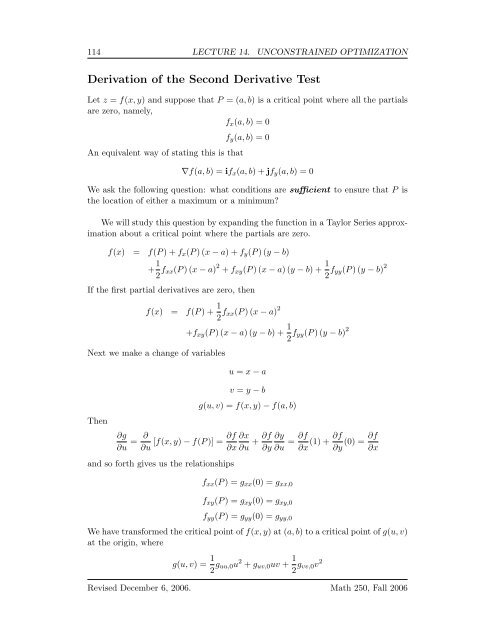Multivariate Calculus - Bruce E. Shapiro
Multivariate Calculus - Bruce E. Shapiro
Multivariate Calculus - Bruce E. Shapiro
Create successful ePaper yourself
Turn your PDF publications into a flip-book with our unique Google optimized e-Paper software.
114 LECTURE 14. UNCONSTRAINED OPTIMIZATION<br />
Derivation of the Second Derivative Test<br />
Let z = f(x, y) and suppose that P = (a, b) is a critical point where all the partials<br />
are zero, namely,<br />
f x (a, b) = 0<br />
An equivalent way of stating this is that<br />
f y (a, b) = 0<br />
∇f(a, b) = if x (a, b) + jf y (a, b) = 0<br />
We ask the following question: what conditions are sufficient to ensure that P is<br />
the location of either a maximum or a minimum?<br />
We will study this question by expanding the function in a Taylor Series approximation<br />
about a critical point where the partials are zero.<br />
f(x) = f(P ) + f x (P ) (x − a) + f y (P ) (y − b)<br />
+ 1 2 f xx(P ) (x − a) 2 + f xy (P ) (x − a) (y − b) + 1 2 f yy(P ) (y − b) 2<br />
If the first partial derivatives are zero, then<br />
f(x) = f(P ) + 1 2 f xx(P ) (x − a) 2<br />
Next we make a change of variables<br />
Then<br />
+f xy (P ) (x − a) (y − b) + 1 2 f yy(P ) (y − b) 2<br />
u = x − a<br />
v = y − b<br />
g(u, v) = f(x, y) − f(a, b)<br />
∂g<br />
∂u = ∂<br />
∂f ∂x<br />
[f(x, y) − f(P )] =<br />
∂u ∂x ∂u + ∂f ∂y<br />
∂y<br />
and so forth gives us the relationships<br />
∂u = ∂f<br />
∂x<br />
f xx (P ) = g xx (0) = g xx,0<br />
f xy (P ) = g xy (0) = g xy,0<br />
f yy (P ) = g yy (0) = g yy,0<br />
∂f ∂f<br />
(1) + (0) =<br />
∂y ∂x<br />
We have transformed the critical point of f(x, y) at (a, b) to a critical point of g(u, v)<br />
at the origin, where<br />
g(u, v) = 1 2 g uu,0u 2 + g uv,0 uv + 1 2 g vv,0v 2<br />
Revised December 6, 2006. Math 250, Fall 2006
















